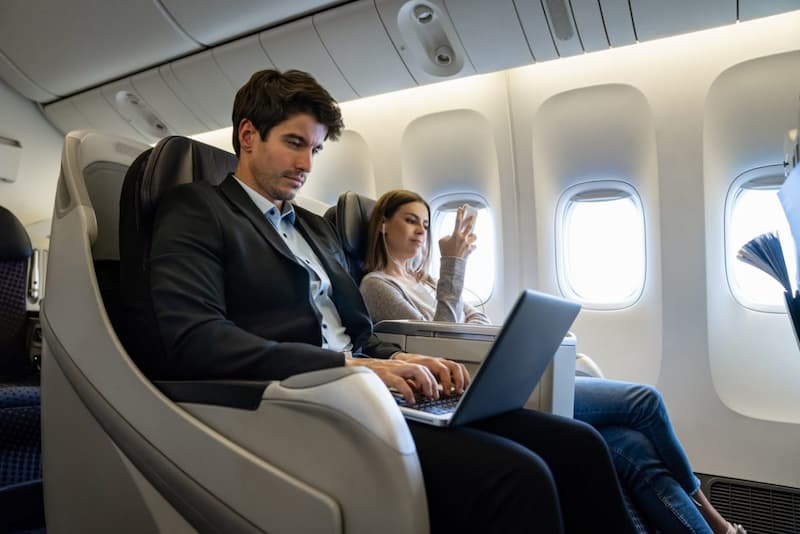Can you bring a laptop on a plane, first? YES!
Small portable electronic devices like mobile phones, tablets and standard sized laptops are allowed on planes. Larger electronic devices need to be individually screened at security checkpoints, including laptops, video game consoles, and DVD players.
For more specific information, keep reading.
Table of Contents
Can You Bring A Laptop On A Plane?
You are permitted to bring a laptop onto any airplane, whether you are flying with Southwest, Delta, United, American Airlines, JetBlue, or any other airline.
There is only one thing to be aware of: some airlines may have restrictions on the number of electronic devices, including laptops, you can bring on a flight.
For instance, American Airlines only allows 2 portable electronic devices while Delta allows 15.
Checked Bags Vs. Personal Bags Carry On Bags
Checked Bags
Laptops with both removable and non-removable batteries are acceptable for checking as carry-on luggage.
Carry-on bags should be packed with spare batteries, though.
Carry On Bags
You are permitted to bring a laptop on a plane in your carry-on bags, and the vast majority of passengers do so.
One thing to keep in mind is that you must take any laptops out of your bag and put them in a different bin for X-ray screening before passing through airport security.
How Many Laptops Are Permitted On A Flight?
In theory, you are free to board a plane with as many laptops as you like.
The number of laptops you can bring on a plane is not capped by the TSA:
“The security checkpoint allows multiple laptops to pass through.”
“Carry-on bags are permitted to contain an unlimited number of laptops.”
However, airlines might have their own rules.
What Size Laptop Can You Take On A Plane?
Your laptop can be any size, provided that it does not exceed the maximum bag dimensions allowed by your airline when traveling.
That is to say, you won’t have any trouble bringing a laptop of any size on a plane due to their compact size.
Can You Use A Laptop On A Plane?
Except for takeoff and landing, you can use a laptop on a plane the entire time.
Although you can still use Bluetooth and Wi-Fi while in flight, your laptop should be in airplane mode.
Because they can become dangerous projectiles in the event of turbulence, laptops must be stored away during takeoff and landing.
How To Use Your Laptop In An Airport Or A Plane
The open Wi-Fi networks that are common in airports are convenient but unsecure. Cybercriminals are aware that travelers use Wi-Fi, and that not everyone has robust security. Download VPN for Mac or PC before logging onto the airport Wi-Fi
Additionally, some consideration is needed when flying with a laptop. Lay your laptop bag down on the plane’s floor, close to your feet. On a bumpy flight, stay away from the overhead storage because it could fly open. As soon as you sit down, resist the urge to open your laptop. Instead, hold off until the announcement is made. The pilot will give you a reminder to activate airplane mode.
Finding a seat next to the window is your best bet if you want to work while flying. When required, you can cover the laptop’s screen to protect it from the sun. Get a privacy display cover as well, if you like. See more about How to Connect AirPods to HP Laptop
Using The Internet While Abroad
As soon as you get there, don’t forget about cybersecurity. In your hotel, restaurants, and cafes, you will likely use the free Wi-Fi, so keep in mind that these connections are notoriously risky. Use your VPN for Mac or PC regularly.
A VPN for Mac or PC will encrypt your connection and make the data you send or receive impossible for a third party to decrypt. An indispensable travel tool, this app might also give you access to websites that are geo-blocked.
Travelers who want an internet connection all day long will benefit from a device called pocket Wi-Fi, read our review about Tep Pocket Wifi here (we have been using it for years). It is a portable, small modem that you can use. Consider it a more compact version of your home router. Despite the limited range of pocket WiFi, you can still connect your laptop and other portable devices.

Things To Remember When Traveling With A Laptop
Everywhere in the world, there are different types of sockets. Purchase a universal adapter in advance of your international trip to make sure your battery is always full. A power surge protection feature ought to be included with the adapter. You wouldn’t want to ruin your laptop while traveling to South East Asia, for instance, where electricity problems are a known problem.
It could be dangerous to travel with a laptop because it could get lost or stolen during transportation. The data would be lost if you purchased a new computer once you got home. Backups can be useful here. Save all of your files to your preferred external hard drive or cloud storage service. Additionally, don’t forget to set a password on your laptop.
Finally, purchasing travel insurance may enhance your experience. Of course, you are free to decide whether to do so; it is not required. Your electronic devices are covered by the insurance in the event they are misplaced or broken while you are traveling.
So our last piece of advice is to read our Travel Insurance Guide. We contrast long-term travel insurance, but you can follow the same advice when purchasing travel insurance for a few days, a few weeks, or a few months. Maintaining your safety and the safety of your valuables is crucial.
Airline Regulations Of Laptops On Board
The FAA and TSA regulate fights that take place within the United States, which is all we’ve discussed so far. However, there are numerous other aviation authorities around the world that can impose various restrictions on laptops in flight. These are only applicable for international flights outside of the United States.
IATA (International Air Transport Association)
The largest regulator, IATA, oversees 290 airlines in 120 nations and is in charge of 82% of all flights, including those throughout all of Europe. Although they advise packing laptops inside hand luggage, they do say that laptops are permitted in both checked luggage and carry-on bags. They must be completely turned off and not in hybernation or sleep mode before being packed in checked luggage.
TCCA (Transport Canada Civil Aviation)
Laptops are permitted in both hand luggage and checked baggage, according to Transport Canada, which oversees flights within Canada.
CAAC (Civil Aviation Administration Of China)
Laptops with more than 160 watt-hour batteries are not permitted on flights that pass through China. You will need the airline’s permission if the laptop’s battery is between 100 and 160 watt hours, while a battery under 100 watt hours won’t require any permissions. Laptops can be packed in both hand and checked luggage, but spare batteries with a capacity of less than 160 watt hours can only travel in hand luggage. Up to 15 laptops and 20 extra batteries may be brought on board by each passenger.
CASA (Civil Aviation Safety Authority)
Australia’s airspace is regulated by CASA. Laptops with batteries under 160 watt-hours may be transported in hand luggage or checked baggage, but those with batteries over 100 watt-hours need airline consent. Batteries with watt-hour capacities greater than 160 are prohibited. Only hand luggage is permitted for spare batteries that are less than 160 watt hours.
Go Through Airport Security With Laptops
Before passing through customs with a laptop, you should be aware of a few things. First, when you’re going through security, take your laptop out of the bag and put it in a different bin so it can be x-rayed. Put each laptop in its own bin if you are bringing more than one.
However, if your bag has a laptop pocket and is TSA-approved, you shouldn’t need to take the laptop out of it. This is due to the fact that these specific laptop sleeves lack pockets and zippers, which could interfere with the x-ray image. A member of our staff uses the Matein 17-inch TSA-Compliant Laptop Backpack as his personal item. Because the laptop sleeve can be unzipped without obstructing the scanner images, he has never been instructed to take the laptop out of the backpack when passing through security.
If you’ve packed multiple laptops in your bag and you’ve already been through security, you shouldn’t have to take them out of your backpack and put them in different bins. Even so, they might still ask you to do it occasionally. The TSA agent you encounter at security has a significant impact. You shouldn’t take the laptops out of your bag without asking first. You risk getting in trouble because security is constantly on the lookout for bomb threats if you attempt to remove any electronic devices from your bag without the TSA officer’s prior approval.
You should always charge your laptop before going through security, which is another crucial step. The TSA officers may request that you turn on your laptop if they decide to conduct an additional inspection for this reason. They have the right to seize your laptop if you are unable to turn it on or if you are unable to respond to basic questions about it. Make sure to always bring fully charged electronics because this rule applies to ALL electronic devices.
Pros & Cons Of Traveling With A Laptop On A Place
The majority of us mistakenly believe that a smartphone can perform tasks that a laptop can, but that isn’t always the case. Whatever adventure you choose to embark on will determine how things turn out. Let’s look at some benefits and drawbacks:
Pros Of Traveling With A Laptop
- A laptop is required for those who work while traveling. Smartphones lack the computing power of a computer, which also has a larger screen and allows for higher levels of productivity.
- In comparison to earlier models, laptops are now much more portable. A single laptop won’t make much of a difference if you are worried about the weight of your luggage.
- Laptops offer a better user experience when completing various forms for backpackers because they are frequently used to make on-the-go hotel and flight reservations.
- When taking a long bus or plane ride, you can use your laptop as entertainment. Or binge Netflix travel shows inside a hotel room if the weather is bad.
Cons Of Traveling With A Laptop
- When unprepared, traveling through an airport with a laptop may be a little annoying. You must take it, along with a charger, out of your laptop travel bag so that it can be checked.
- Leave the majority of your valuables at home when visiting a dangerous city or country. A safe or a locker should be available in the hotel room if you have to bring your laptop with you.
The End
Can You Bring A Laptop On A Plane? was the main topic of the article.
US-based airlines are permitted to carry musical instruments on board in accordance with FAA regulations if they are small enough to fit in the overhead bin or beneath the seat in front of you.
Are you knowledgeable about whether a laptop can be brought on a plane? Are you planning to travel with a laptop?
Feel free to post a comment if you have any queries.
We appreciate you reading.
